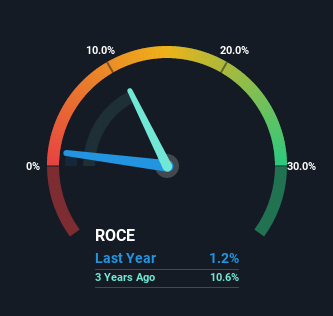- Malaysia
- /
- Semiconductors
- /
- KLSE:DNEX
There Are Reasons To Feel Uneasy About Dagang NeXchange Berhad's (KLSE:DNEX) Returns On Capital
If we want to find a stock that could multiply over the long term, what are the underlying trends we should look for? Typically, we'll want to notice a trend of growing return on capital employed (ROCE) and alongside that, an expanding base of capital employed. Put simply, these types of businesses are compounding machines, meaning they are continually reinvesting their earnings at ever-higher rates of return. Although, when we looked at Dagang NeXchange Berhad (KLSE:DNEX), it didn't seem to tick all of these boxes.
Return On Capital Employed (ROCE): What Is It?
If you haven't worked with ROCE before, it measures the 'return' (pre-tax profit) a company generates from capital employed in its business. To calculate this metric for Dagang NeXchange Berhad, this is the formula:
Return on Capital Employed = Earnings Before Interest and Tax (EBIT) ÷ (Total Assets - Current Liabilities)
0.012 = RM24m ÷ (RM2.2b - RM230m) (Based on the trailing twelve months to June 2021).
So, Dagang NeXchange Berhad has an ROCE of 1.2%. In absolute terms, that's a low return and it also under-performs the IT industry average of 11%.
Check out our latest analysis for Dagang NeXchange Berhad

Above you can see how the current ROCE for Dagang NeXchange Berhad compares to its prior returns on capital, but there's only so much you can tell from the past. If you'd like to see what analysts are forecasting going forward, you should check out our free report for Dagang NeXchange Berhad.
What Does the ROCE Trend For Dagang NeXchange Berhad Tell Us?
On the surface, the trend of ROCE at Dagang NeXchange Berhad doesn't inspire confidence. Around five years ago the returns on capital were 13%, but since then they've fallen to 1.2%. Given the business is employing more capital while revenue has slipped, this is a bit concerning. This could mean that the business is losing its competitive advantage or market share, because while more money is being put into ventures, it's actually producing a lower return - "less bang for their buck" per se.
On a side note, Dagang NeXchange Berhad has done well to pay down its current liabilities to 11% of total assets. That could partly explain why the ROCE has dropped. What's more, this can reduce some aspects of risk to the business because now the company's suppliers or short-term creditors are funding less of its operations. Since the business is basically funding more of its operations with it's own money, you could argue this has made the business less efficient at generating ROCE.
The Key Takeaway
We're a bit apprehensive about Dagang NeXchange Berhad because despite more capital being deployed in the business, returns on that capital and sales have both fallen. The market must be rosy on the stock's future because even though the underlying trends aren't too encouraging, the stock has soared 102%. In any case, the current underlying trends don't bode well for long term performance so unless they reverse, we'd start looking elsewhere.
On a final note, we've found 3 warning signs for Dagang NeXchange Berhad that we think you should be aware of.
While Dagang NeXchange Berhad may not currently earn the highest returns, we've compiled a list of companies that currently earn more than 25% return on equity. Check out this free list here.
New: Manage All Your Stock Portfolios in One Place
We've created the ultimate portfolio companion for stock investors, and it's free.
• Connect an unlimited number of Portfolios and see your total in one currency
• Be alerted to new Warning Signs or Risks via email or mobile
• Track the Fair Value of your stocks
Have feedback on this article? Concerned about the content? Get in touch with us directly. Alternatively, email editorial-team (at) simplywallst.com.
This article by Simply Wall St is general in nature. We provide commentary based on historical data and analyst forecasts only using an unbiased methodology and our articles are not intended to be financial advice. It does not constitute a recommendation to buy or sell any stock, and does not take account of your objectives, or your financial situation. We aim to bring you long-term focused analysis driven by fundamental data. Note that our analysis may not factor in the latest price-sensitive company announcements or qualitative material. Simply Wall St has no position in any stocks mentioned.
About KLSE:DNEX
Dagang NeXchange Berhad
An investment holding company, engages in information technology (IT) and eServices, and energy businesses in Asia, Europe, and North America.
Reasonable growth potential with adequate balance sheet.
Market Insights
Community Narratives



